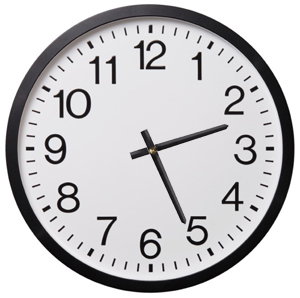
Plus Advent Calendar Door #20: Cyclic groups
This article is about understanding abstracts objects called groups. If you don't know what they are, then you might want to read this brief explanation.
Some things go round and round. An example are the hours of a clock. If you start at 12 and add one hour you get to 1, add another hour and you get to 2, and so on, until after twelve additions you're back to where you started.
You could also think of this in terms of rotating the clock face through a twelfth of a circle. One rotation moves 12 to 1, another rotation moves 1 to 2, and so on, until after twelve rotations you get back to where you started.
In each case you have a collection of twelve things: twelve numbers, or twelve rotations (the rotations are through 1/12 of a circle, 2/12 of a circle, 3/12 of a circle, and so on). You also have a way of combining one thing with another to get a third: adding two numbers, or following one rotation by another. And you have one very special thing that lets you generate all the others: you can get to any of the twelve numbers from 1 by repeatedly adding one, and similarly, repeatedly performing rotations through a twelfth of a circle gives you all the other rotations in your collection.

A clock gives a good example of a cyclic group
If a collection of objects, together with a binary operation that combines two objects to give you a third, adheres to certain rules, then mathematicians call it a group — you can find out more about these rules here. And if a group contains a special object that, through repeated application of the binary operation can generate all other objects in the group, then the group is called a cycling group.
Cyclic groups exist in all sizes. For example, a rotation through half of a circle (180 degrees) generates a cyclic group of size two: you only need to perform the rotation twice to get back to where you started. Similarly, a rotation through a 1/1,000,000 of a circle generates a cyclic group of size 1,000,000. Generally, a rotation through a 1/nth of a circle, where n is any positive integer, generates a cyclic group of order n.
Is there also an infinite cyclic group? We could try making one by taking the number 1, and instead of imagining it to be part of the clock face where things go round and round, we imagine it as the ordinary number 1 on the number line. By repeatedly adding 1s you can get to each of the infinitely many positive integers. So do the positive integers form an infinite cyclic group generated by 1?
The answer is no. That's because the positive integers don't form a group in the first place. According to the definition of a group, a group must contain an identity element, and every other element must have an inverse (see here to find out what that means). For the integers, the identity element is 0, and the inverse of every other element is the negative of that number. So to get a group we must include, not just the positive integers, but also 0 and the negative integers.
Now if we are more generous with the definition of a cyclic group, allowing not just one element but also its inverse to help us get to all the other elements, then the integers are an infinite cyclic group generated by 1 (with the help of its inverse -1). Starting with 1 and -1 we can get to any other integer by repeatedly adding 1s or -1s.
This more general definition is the official definition of a cyclic group: one that can be constructed from just a single element and its inverse using the operation in question (e.g. addition or composing rotations). Note that for finite groups the two definitions coincide because the inverse of the generating element can itself be constructed from that generating element. For example, for the twelve numbers on the clock, the identity element is 12: if you add 12 to any number in this group, the number remains unchanged. The inverse of 1 is 11, because 1+11=12. Since you can get from 1 to 11 by adding 1s, this means that 1 generates its own inverse and is therefore enough to give you the whole group.
Return to the Plus advent calendar 2021.
About this article
This article is part of our collaboration with the Isaac Newton Institute for Mathematical Sciences (INI), an international research centre and our neighbour here on the University of Cambridge's maths campus. INI attracts leading mathematical scientists from all over the world, and is open to all. Visit www.newton.ac.uk to find out more.
